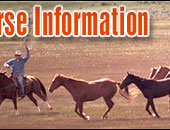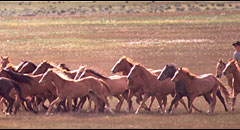 |
   |
|
|
|
You are here: Horses > Horse training > Loading a Horse |
|
Horse Travel: Training Your Equine to Load into a Transprotation Trailer
Getting a horse into a trailer is one of life's great
challenges, especially if the horse isn't sure that's where
he wants to be. Aside from wasting time and getting people
(and horses) upset, loading can be dangerous when people
become impatient and try shoving, yanking or forcing a
horse into a trailer; an annoyed or frightened horse can
react by lashing out with hooves, biting or just mashing
you against the side or front of the trailer. |
|
|
There are ways to teach a
horse to load properly, and like all training endeavors,
their relative ease depends on your patience and your
horse's history. If your horse has had a bad time being
loaded, has been pushed or abused or roped in the past,
chances are it's going to take some time to get him used to
going quietly and easily up a ramp and into a dark trailer.
On the other hand, if you start a young horse's training
early, you will be rewarded with a horse who thinks that
loading up to go somewhere is part of normal, everyday
equine doings. |
Getting Started at a Walk
When you're training your horse to do something that has
several parts (walk up the ramp, stop at the end, stand
still, don't back out, etc.), you have to break the training
down into those parts. In loading, your first objective is
to teach your horse the command "walk". Start in an arena:
you'll get to the trailer later. Use a long lead rope with a
32-inch chain over his nose and up his offside cheek, take
the lead in your left hand and a dressage whip in your
right. Give him lead and say , "walk", with a light tap on
the rump to urge him forward. Once he's taken a few steps,
say "whoa" and pull on the lead to tell him to stop. When
you tell him again to walk and he does, praise him. If he
shows displeasure by shoving you or turning sharply in front
of you, start again and keep at it until he can walk when
you ask him to and stop without backing up. Ideally, he'll
walk when you say "walk" and the dressage whip will gather
dust.
Trailer
Once your horse has learned "walk", it's a matter of
convincing him that it's necessary to walk into the trailer.
Don't try to lead him in: that's one way people get injured.
The idea is, he'll go in under his own steam. You may have
to let him walk partway up and stop, then start again. He
may try to back up: if he does, let him go and then load him
again.
This is where patience comes in: if yours is greater than
your horse's, you will win and your horse will load. If you
let him win, you'll be stuck with a horse who makes it a
hassle every time you want to go somewhere. When he backs
out of the trailer, remind yourself that patience counts.
You won't take a break, leaving him to think (know) he's
won. You will patiently, stolidly walk him back into that
darned trailer until he realizes that you will never become
bored with this project. At that point, he will start to
understand that he's going to keep walking up that ramp
until the end of time—or until he stays put.
If you must tap your horse on the rump to get him to move
forward, you'll already know that from your work in the
arena. (It isn't preferable, but sometimes it's just that
way). But don't hit your horse in the trailer—it's dangerous
for both of you—and never hit him if he's doing what you've
asked. Once he's complied, praise him and let him rest.
(That way he knows that once he's done it right, the tedium
stops).
Training takes time. Expect it to take several sessions
before your horse knows "walk" and "whoa": dealing with
things like steps will take more time. You should also load
your horse at different times of day: loading at night is a
variation on the theme.
 |
Read the next horse training article on Trained Horses Need a Break. |
|
|
|
|
 |
|
|
|
|
|
Horse Education
|
|
|
|
|
Horse Information Topics
|
|
|
|
|
|
|
|
Horse Business Owners
|
| |
Advertise with Us
Have your horse products or services exposed to over 27,000 of our monthly visitors.
|
|
|
|
|
|